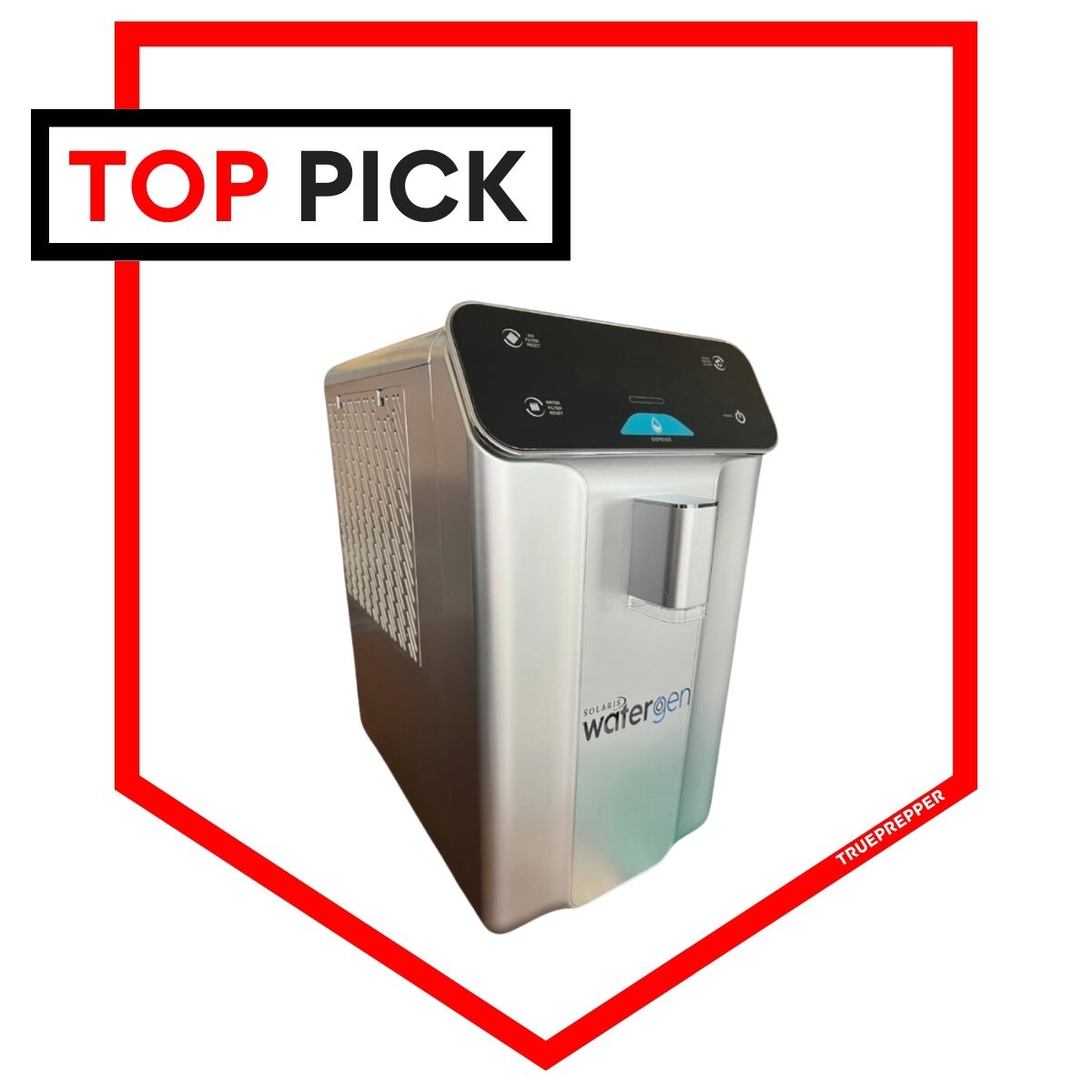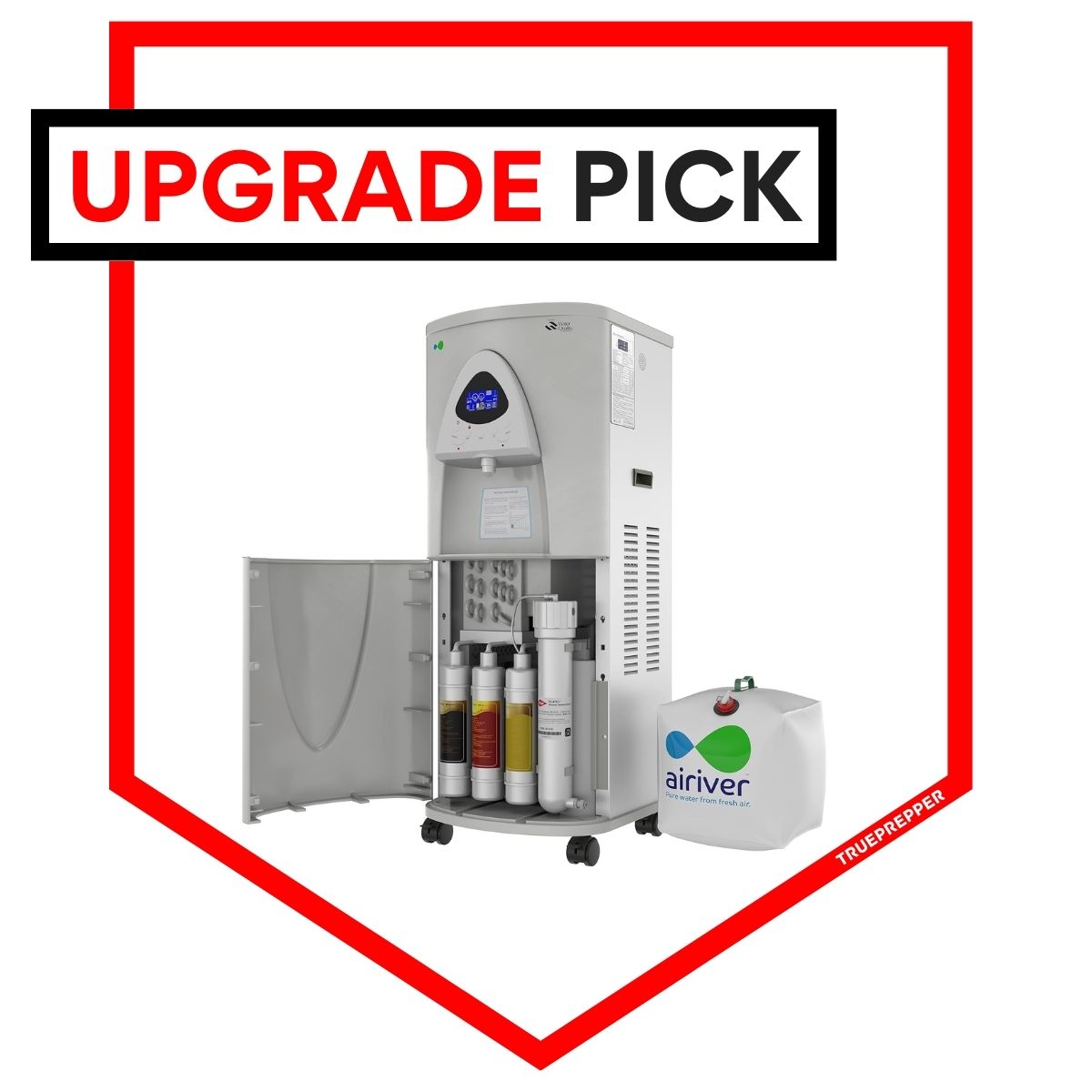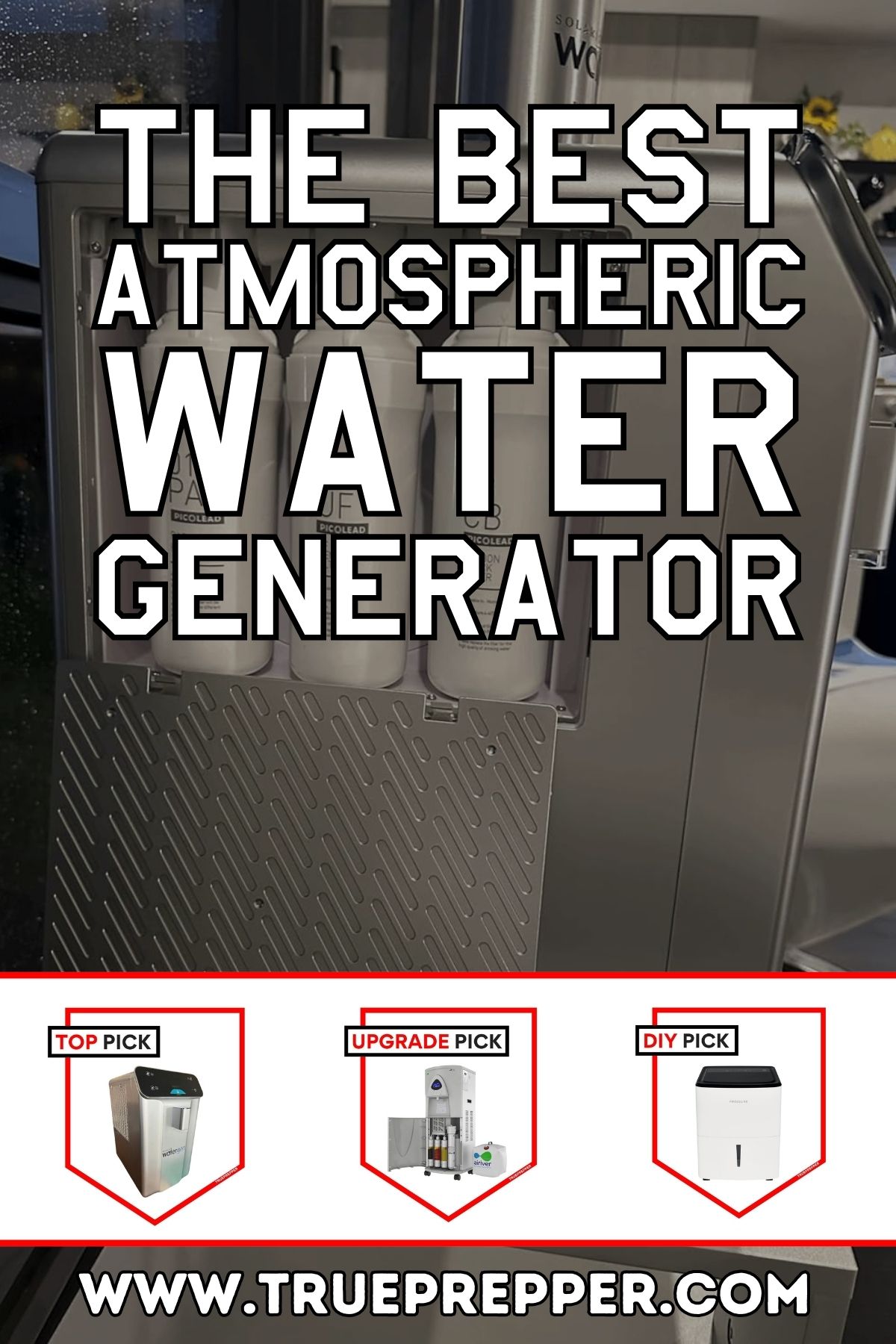This is an updated review of the best atmospheric water generators. We review our picks about once per year to make performance updates and evaluate any new equipment available.
Atmospheric water generators (AWGs) have been in high demand, and it’s easy to see why. Swapping energy for clean drinking water is useful anywhere in the world. Tons of companies have sprouted up taking their shot at making the best atmospheric water generator. Creating water from thin air is nothing new, but being able to do it efficiently, at scale, and have it taste great is the challenge these AWGs have to meet. There are several options to consider when it comes to atmospheric water generators: capacity, filtering, energy needs, etc.
This is where we come in. We’ve researched the best water generators, and compared them, and now the results are in: the overall best, a budget DIY option, and an upgrade option. If you need to generate water from the air, one of our recommendations will keep your thirst quenched.
Contents (Jump to a Section)
The Best Water Generator
Compact, Efficient, and Effective
Pulling water out of thin air like magic, this AWG makes it all easy and serves it to you cold.
*Price at time of publishing; check for price changes or sales.
WaterGen makes water generation effortless. Not long ago they only supplied large businesses and industrial units, but for 2024 they launched this great countertop model making water generation more accessible than ever.
If you have energy, you have water. With integrated filtering, it produces great-tasting water and can serve it up cold. With ideal conditions it can support a couple, pulling several gallons per day out of the air.
Here is how it measures up:
- Up to 2.7 gallons / 10 L water per day
- Cold tap, LCD
- HEPA air filter, sediment filter, pre-carbon filter, ultra-fine membrane filter, mineral filter, and UV lights
- 10.2″ W x 17.5″ D x 14.4″ H
- 110V, 200W running, 23W per liter produced
- 31 pounds
With specs like these, it’s easy to see how the Solaris WaterGen Countertop Water Generator is the best atmospheric water generator.
Upgrade Water Generator
Effective, Efficient, and Great-Tasting
Providing a family with a consistent water source is easy with this model that has it all thought out.
*Price at time of publishing; check for price changes or sales.
There are several similarities to our top pick, but this model has more bells and whistles. It is slightly larger and slightly more energy efficient. It also has some features that improve versatility, including the removable water reservoir.
Here are the details:
- Up to 8 gallons / 30 L water per day
- Hot and cold tap, LCD & controls
- HEPA air filter, reverse osmosis system, and multi-stage UV lights
- Portable, removable reservoir
- 16″ W x 16″ D x 44″ H
- 110V, 400W running, 300W per liter produced
- 90 pounds
If you are looking for the best of the best, pick up the Airiver Atmospheric Water Generator.
DIY Water Generator
DIY Project, Effective, and Inexpensive
If you are willing to tackle a project and a few extra hassles, a modded dehumidifier can save you a lot of money.
*Price at time of publishing; check for price changes or sales.
We understand that the price point of an AWG can rule some out, but there is some hope if you have some spare time and are willing to hack/DIY some things together. To create a budget atmospheric water generator, you’ll need to snag a dehumidifier. Here is the model we suggest:
For comparison purposes, here are the dehumidifier specs:
- Up to 4 gallons / 15 L water per day (only 2-gallon built-in reservoir)
- Grey water
- Dust filter only
- 16″ W x 12″ D x 20″ H
- 110V, 380W running
- 36 pounds
With a small reservoir, it makes sense to drain the dehumidifier continuously into a water storage container with a drain hose:
Position the dehumidifier on top of the barrel and attach the water hose to be gravity-fed from the dehumidifier to the barrel.
Dehumidifiers aren’t concerned about water quality, so you will need to filter it and purify it yourself at some point. Some opt to do this in-line (like a true AWG) and others store the water grey and do it later (less ideal).
While a typical AWG does all of this for you, doing it manually yourself will still total less than 20% of the cost of an atmospheric water generator. All of the components from this project are versatile on their own as well- use the water storage barrel to store water from multiple collection sources.
Lastly, there are some limitations to this DIY hack besides all of the manual filtering and additional components. Dehumidifiers are not meant to run at low humidity and have much more trouble pulling water out of low-humidity environments, so this will be much less efficient (or will not even turn on depending on your model settings) if you live in a less humid climate. They also do not run well in cold temperatures (<40 F). Consider these limits before you go out building an AWG on your own.
Everything We Recommend

Solaris WaterGen
Pulling water out of thin air like magic, this AWG makes it all easy and serves it to you cold.
Where to Buy
$1,890* at Amazon
*at time of reviewing

Airiver AR-30
Providing a family with a consistent water source is easy with this model that has it all thought out.
Where to Buy
$2,989* at Amazon
*at time of reviewing
The Water Generators We Compared
Our research narrowed the field down to the several AWGs that we compared: NUBE, Aerowater, NRG, Airiver, SkyWater, Tsunami, SunToWater, H20Machine, Genaq, WaterGen, and more.
You can see our full list of review criteria below in the What to Look For section, with an explanation for each.
We focused on AWGs with a maximum capacity of 8 gallons or less. There is a variety of options over that capacity for commercial, government, and community use but 8 gallons should be good enough for a family of four, and it allowed us to baseline and compare brands across the same capacity.
We’re always looking for new and better equipment, so if you have a water generator that you swear by let us know in the comments. Also, if you have a DIY solution as we do for our budget option, let us know. We review most of our tested equipment annually, so we can always get it in the next roundup round and see if it makes the cut and we can see if it will beat out our top picks.
What to Look For
The best atmospheric water generators have several important features to look for:
- Value
- Capacity
- Filtering
- Energy Needs
- Quality
When you get the right blend of these, you can find a water generator that will consistently pull gallons of water out of the air. Below, we break down what each of these features means for the AWGs that truly set themselves apart.
Value: Cost vs. Benefit
The amount of money you spend on something like an atmospheric water generator shouldn’t blow out your entire budget, although that can be a tough ask at these price points. Don’t go overspending or overdo it. Going with our DIY budget pick isn’t the end of the world. Budget according to your risk and your needs rather than just spending lavishly.
On the flip side, you don’t want to go too cheap or just plain get the wrong thing. Handheld and portable AWGs do not exist, though you may see a few claims here and there online. Don’t go out and get something scammy- you may need to rely on it for water in a real-life situation.
You never want to spend too much money on one resource, especially something like an appliance. It’s better to diversify your preparedness gear to make sure you are covered for a wide range of scenarios.
Capacity
There are many types of models of AWGs, and they have a large range of capacities.
Our suggestions are on the lower end of the spectrum, starting at 8 gallons/day.
But, AWGs can go all the way up to 1,580 gallons/day. To grab a model capable of this, like the WaterGen Gen-L, you’ll need to pony up at least $68,000. That may be easily worth it for a community and is still much cheaper than desalination.
Filtering
One of the main features of an AWG is that it doesn’t just produce water- it gives you drinkable water. It does this using multi-stage filters, usually including carbon and reverse osmosis to make the water safe to drink, pH balanced, and natural tasting.
Some models use UV light and electrolysis as well. If you are considering the DIY budget plan, you will need to seriously filter and purify your water because even water from the air can carry persistent bacteria and viruses.
Energy Needs
Our picks are some of the smallest AWGs on the market, and also pull the least amount of energy. Even still, there are serious energy needs for any powered system that is separating water out of the air.
If you plan to power it using conventional generators in an emergency, you can end up using A LOT of fuel for just a little bit of water in return.
Plan how you will provide 300-600 Watts to power these sustainably in an emergency.
Quality
When you invest in an appliance, quality is important. Especially if that appliance is a part of your emergency plans. Besides the manufacturing quality inherent in the AWG, the service quality is important too.
You’ll also need a reliable supplier for your AWG because there are replaceable components inside of them that you will either need to have on hand or be able to get them quickly. These include various filters, UV lights, and replacement parts. All of our picks are reputable brands that have excellent service departments that were able to answer all of our questions.
How to Use an Atmospheric Water Generator
AWGs make water collection easy- they are the ‘fire and forget’ option to sourcing water in an emergency if you have the proper equipment, supplied power, consumable part stock, and know how to use and maintain it.
Using an AWG is easy, but maintenance takes a little more know-how. There are several filters to stay on top of, and it’s best to have several spares on hand.
Here is Family Man Prepper on YouTube showing off our previous top pick:
Who Needs a Water Generator?
Water generators are slowly pushing the entire world forward by solving water demands across the globe. But do you need one for your personal use? Sure!
In our context, we consider water generators to be great solutions if you are energy-independent and have spare energy under emergency use. Practically, this greatly reduces the number of people (and preppers) who can access ARGs as a solution.
Nevertheless, a water generator is a great solution installed in your home as part of your:
It is worth noting the equipment limitations, and that a few select threats (such as an EMP) could disrupt your plan to use AWGs as your primary water source.
How We Review Products: We research thoroughly before selecting the best products to review. We consult experts in the field for a better understanding of what makes the gear great. Hours on end are spent field testing gear in stressful conditions. We assign performance criteria and impartially rate each tested item. After our review process, some of the items reviewed end up in our giveaways.
Sources and References
All of our experience and the testing we do to determine the best atmospheric water generator is useless without listing our research sources and references. We leaned on these for the book knowledge that we paired with our hands-on testing and practical military and prepping experience:
Shafeian, N., et al. (2022). Progress in atmospheric water generation systems: A review. Renewable and Sustainable Energy Reviews. Volume 161. (Source)
Shourideh, A., et al. (2018). A comprehensive study of an atmospheric water generator using Peltier effect. Thermal Science and Engineering Progress. Volume 6. Pages 14-26. (Source)
Raveesh, G., et al. (2021). Advances in atmospheric water generation technologies. Energy Conservation and Management. Volume 239. (Source)
The Final Word
You can’t live long without water- it’s a necessity for survival. Atmospheric water generators are an excellent way to have another self-reliant water source. Even if you have a well or city tap, remember the rule of thumb: two is one and one is none.
Here are a few other reads our subscribers have also found helpful:
We presented quite a lot of information, but as always: if you have any questions let us know and we would be happy to help. Our research and testing found the Solaris WaterGen Atmospheric Water Generator to be the best option given its value, capacity, filtering, energy needs, and quality.
Keep exploring, stay prepared, and be safe.
You’ve Been Missing Out
Join the 2+ million preppers that rely on our prepping advice by subscribing to TruePrepper.
- Practical guides and tips
- Useful survival giveaways
- Free, forever
- < 0.4% of people unsubscribe
Thanks for subscribing, reading, and welcome to the club.

The post Best Atmospheric Water Generator | Make Water From Thin Air appeared first on TruePrepper.
https://trueprepper.com/atmospheric-water-generator/
 CampingSurvivalistHuntingFishingExploringHikingPrivacy PolicyTerms And Conditions
CampingSurvivalistHuntingFishingExploringHikingPrivacy PolicyTerms And Conditions
